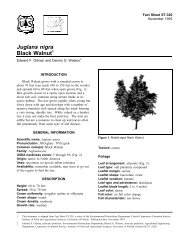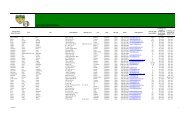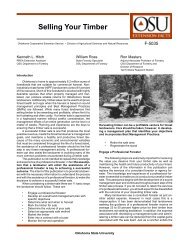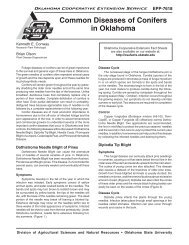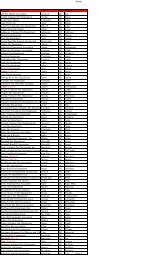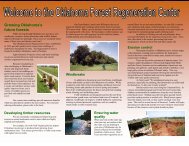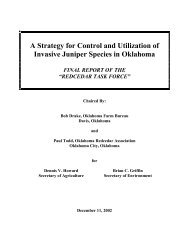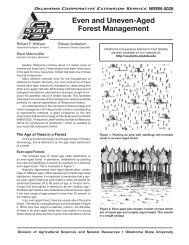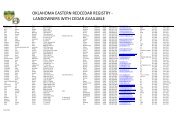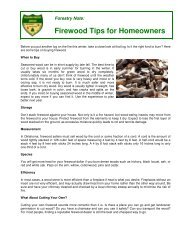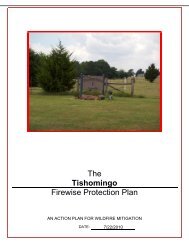Best Management Practices for Forest Road Construction and ...
Best Management Practices for Forest Road Construction and ...
Best Management Practices for Forest Road Construction and ...
- No tags were found...
Create successful ePaper yourself
Turn your PDF publications into a flip-book with our unique Google optimized e-Paper software.
<strong>Best</strong> <strong>Management</strong> <strong>Practices</strong><strong>for</strong> <strong>Forest</strong> <strong>Road</strong> <strong>Construction</strong><strong>and</strong> Harvesting Operationsin OklahomaCooperative Extension ServiceDivision of Agricultural Sciences<strong>and</strong> Natural ResourcesOklahoma State University<strong>Forest</strong>ry Extension Report #5
Prepared by:Donald TurtonAssociate Professor, <strong>Forest</strong> HydrologyDepartment of <strong>Forest</strong>ryOklahoma State UniversitySteven AndersonExtension <strong>Forest</strong>erDepartment of <strong>Forest</strong>ryOklahoma State UniversityRobert Miller<strong>Forest</strong> Hydrologist<strong>Forest</strong>ry Services Division,Oklahoma Department of Agriculture, Food, <strong>and</strong> <strong>Forest</strong>ryKenneth HitchRREA Extension AssistantDepartment of <strong>Forest</strong>ryOklahoma State UniversityThis guide was developed with the cooperation of the OklahomaState University Department of <strong>Forest</strong>ry; the Oklahoma CooperativeExtension Service; the <strong>Forest</strong>ry Services Division of theOklahoma Department of Agriculture, Food, <strong>and</strong> <strong>Forest</strong>ry; <strong>and</strong>the Oklahoma <strong>Forest</strong>ry Association.Funding <strong>for</strong> preparation <strong>and</strong> printing of this guide was providedby the Oklahoma Conservation Commission through an EPA 319Grant; Oklahoma <strong>Forest</strong> Stewardship Program administered byOklahoma Department of Agriculture, Food, <strong>and</strong> <strong>Forest</strong>ry; theRenewable Resources Extension Act; the Weyerhaeuser Foundation;<strong>and</strong> the Oklahoma <strong>Forest</strong>ry Association.
ContentsIntroduction............................................................................ 2Streamside <strong>Management</strong> ..................................................... 3<strong>Forest</strong> <strong>Road</strong>s ......................................................................... 5Existing <strong>Road</strong>s—Repair or Relocate?................................... 5Temporary <strong>Road</strong>s.................................................................. 6Permanent <strong>Road</strong>s.................................................................. 6<strong>Road</strong> Location Guidelines..................................................... 7<strong>Road</strong> Design Guidelines........................................................ 7<strong>Road</strong> Erosion Control Guidelines.......................................... 7<strong>Road</strong> Cross-sections............................................................. 8Cross-drain Culverts.............................................................. 8Culvert Installation............................................................... 11Drainage Dips...................................................................... 11Water Bars........................................................................... 15Water Bar Installation...................................................... 15Turnouts or Wing Ditches.................................................... 17Turnout Installation......................................................... 17Mulching <strong>and</strong> Seeding......................................................... 17Stream Crossings................................................................ 19Types of Crossings......................................................... 20<strong>Road</strong> Maintenance ............................................................. 24Maintenance Guidelines................................................. 24<strong>Road</strong> Closure....................................................................... 24Closure Guidelines.......................................................... 24Harvesting............................................................................. 25Cutting................................................................................. 25Skid Trails............................................................................ 25L<strong>and</strong>ings................................................................................ 26During Harvest................................................................ 26After Harvest........................................................................ 26Additional In<strong>for</strong>mation......................................................... 27Field Offices, <strong>Forest</strong> <strong>Management</strong>, <strong>and</strong> WildfireProtection............................................................................. 281
Streamside <strong>Management</strong>Proper streamside management is one of the most importantpractices you can consider to help maintain water quality. Careis needed during road construction <strong>and</strong> harvesting to protectstreams <strong>and</strong> streambanks from erosion. Streamside vegetation<strong>and</strong> l<strong>and</strong> buffers protect streambanks <strong>and</strong> stream channels fromerosion, cool stream water by providing shade, <strong>and</strong> help to filtersediment <strong>and</strong> nutrients from disturbed areas.Strips of l<strong>and</strong> left between streams <strong>and</strong> disturbed areas arecommonly known as streamside management zones (SMZs)(Figure 1). <strong>Management</strong> practices may be modified in an SMZ,depending on the l<strong>and</strong>owner’s objectives. Follow these guidelineswhen operating near streams:• Establish <strong>and</strong> operate within the SMZs in accordance withthe l<strong>and</strong>owner’s <strong>for</strong>est management plan.• Leave a minimum of 50 feet between roads <strong>and</strong> streams.• Be<strong>for</strong>e logging, mark a SMZ between streams <strong>and</strong> harvestedareas or roads. Width of SMZ will depend on local conditions.*A minimum width of 50 feet on each side of the stream is agood rule of thumb.• Keep skidders away from streambanks.• Under wet conditions, keep heavy equipment out of SMZ.Use a cable skidder if available.• Do not skid across streams.• Remove tops or large limbs from stream channels.* Widths should be adjusted <strong>for</strong> slope <strong>and</strong> other site conditions.Consult with the agencies listed in the back of thisdocument.3
Figure 1. A typical Streamside <strong>Management</strong> Zone4
<strong>Forest</strong> <strong>Road</strong>sErosion from <strong>for</strong>est roads is the major source of sediment from<strong>for</strong>estry operations. Plan ahead! In order to ensure fairness toboth the logger <strong>and</strong> l<strong>and</strong>owner, the road system should be partof an overall <strong>for</strong>est management plan. Early planning will savetime <strong>and</strong> money as well as protecting water quality.<strong>Road</strong> planning involves decisions that are of concern to both thelogger <strong>and</strong> the l<strong>and</strong>owner. There<strong>for</strong>e, loggers <strong>and</strong> l<strong>and</strong>ownersshould plan together. Planning involves such factors as makingchoices between permanent <strong>and</strong> temporary roads, relocation <strong>and</strong>repair of existing roads, type <strong>and</strong> number of stream crossings,alternative access points, <strong>and</strong> the expected use of the roads bythe l<strong>and</strong>owner <strong>and</strong> logger.Existing <strong>Road</strong>s: Repair or Relocate?Many <strong>for</strong>ested tracts in Oklahoma already have existing roads.Use existing roads whenever possible. Un<strong>for</strong>tunately, many ofthese existing roads are eroding <strong>and</strong> have washed-out areas dueto lack of maintenance or bad location <strong>and</strong> design. Old roadsmay not meet present BMP guidelines <strong>for</strong> design or location. Ifexisting roads can be improved to meet current st<strong>and</strong>ards, theyshould be used, as new road construction or relocation of existingroads can be expensive <strong>and</strong> may cause significant erosion<strong>and</strong> sediment movement in the short term.Consider the effects of construction, continued use, <strong>and</strong> maintenancewhen making decisions as to whether to use existingroads or construct new ones.5
Decisions on whether or not to improve or relocate existing roadsmay require experienced judgment. In such cases:• Apply BMPs to the degree possible within the limitations ofthe road system.• Relocate roads only if it will result in less erosion in the longterm.• Consult the <strong>for</strong>est management plan or the agencies listed.Temporary <strong>Road</strong>sWhere timber harvest occurs infrequently <strong>and</strong> future access <strong>for</strong>recreation <strong>and</strong> fire control is not needed, temporary roads shouldbe used. Temporary roads are used during harvest operations<strong>and</strong> promptly closed. In general, temporary roads cost less.They are recommended <strong>for</strong> l<strong>and</strong>owners who are away from theirproperty <strong>for</strong> extended periods <strong>and</strong> cannot per<strong>for</strong>m the constantmaintenance required by permanent roads. However, poorlylocated <strong>and</strong> installed temporary roads may erode <strong>and</strong> becomepermanent gullies.Follow the location, design, erosion control, stream crossing,<strong>and</strong> closure guidelines listed in this guide.Permanent <strong>Road</strong>sPermanent roads may be necessary to provide future access <strong>for</strong>recreation, fire control, <strong>and</strong> timber harvest. Permanent roads areexpensive <strong>and</strong> usually require a greater amount of soil disturbanceduring construction. Permanent roads also require regularmaintenance.6
<strong>Road</strong> Location GuidelinesThe following location <strong>and</strong> design guidelines are <strong>for</strong> rehabilitatedold roads, new roads, temporary roads, <strong>and</strong> permanent roads,except where noted.• Plan ahead!• Use the minimum number of roads necessary to get the jobdone.• Minimize stream crossings.• Allow <strong>for</strong> properly sized SMZs when locating roads.• Keep roads out of SMZs except at stream crossings.• Avoid unstable <strong>and</strong> poorly drained areas.• Locate roads along ridges whenever possible.<strong>Road</strong> Design Guidelines• Use the smallest road needed <strong>for</strong> the planned use.• Use temporary roads whenever possible.• Use gravel to surface high-traffic roads.• Keep sustained grades on permanent roads to no more than10 percent. Allow grades up to 18 percent where pitches areshort <strong>and</strong> steep, but not more than 500 feet long.• Balance road cuts <strong>and</strong> fills. Do not borrow from roadsideslopes.<strong>Road</strong> Erosion Control GuidelinesThe main objective of erosion control on <strong>for</strong>est roads is to keepwater from accumulating <strong>and</strong> concentrating on the road surface.Fast-moving water can readily erode soil from road surfaces.When water is dispersed at regular intervals, road erosion canbe controlled.7
<strong>Road</strong> Cross-sectionsThe commonly used road cross-section designs are crowned,outsloped, <strong>and</strong> insloped (Figure 2).Crowned roads may be used in all terrains. Water turnouts <strong>and</strong>cross-drains must be provided.Outsloped roads may be built in moderately sloping terrain,such as roads on upper parts of long slopes.Outsloped roads are not suitable <strong>for</strong> deeply cut side-hillroads or in locations where upslope drainage areas arelarge.Insloped roads may be used on sharp, steep turns as a safetyprecaution.Cross-drain CulvertsCross-drains provide drainage relief to upslope ditches. To minimizeditch erosion <strong>and</strong> prevent washouts, space cross-drainsmore closely on steeper slopes (Table 1).Culvert size should be selected according to the road area <strong>and</strong>hillslope area drained by the ditch (Table 2). To avoid clogging,do not use culverts smaller than 12 inches in diameter.8
Figure 2. <strong>Road</strong> Surface Cross Sections (road surface slope - onehalf inch per foot)9
Table 1Recommended Spacing of Cross-drain Culverts<strong>Road</strong> Grade (%)Spacing (feet)2-5 500-3006-10 300-20011-15 200-10016-20 100Table 2Recommended Diameters of CulvertsBased on Drainage AreaPipe Diameter(inches)Area Above Pipe(acres)12 215 418 721 1224 1630 2736 4742 6448 9054 12060 16066 20572 25078 35010
Culvert InstallationPlug the ditch immediately downhill of the culvert inlet to directall water into the culvert (Figure 3).Extend the culvert outlet beyond the fill slope. Install rocks orslash at the outlet to prevent erosion by concentrated flow.• Angle culverts 30 degrees downslope.• Make culvert gradients at least two percent greater than theditch gradient.• Locate culverts so they do not outlet directly into streams.Drainage DipsDrainage dips provide cross drainage <strong>and</strong> drainage of water thatcollects on road surfaces. Dips can be used instead of crossdrainculverts, usually at lower cost. They are especially wellsuited <strong>for</strong> temporary roads. Dips must be deep enough to provideadequate drainage, but wide enough to allow the safe passageof trucks <strong>and</strong> equipment. The type of dip selected depends onexpected use <strong>and</strong> type of road. The spacing of drainage dipsis determined by slope steepness <strong>and</strong> local conditions (Table3 on page 15). Place rock or slash below the outlet to preventerosion.Rolling dips (Figure 4) are best <strong>for</strong> spur <strong>and</strong> temporary roadsthat have little traffic at low speeds. Rolling dips resemble“stretched out” water bars. The dip is excavated out of theexisting road grade.Broad-based dips (Figure 5) are best <strong>for</strong> roads with high trafficvolumes <strong>and</strong> speeds, such as permanent main haul roads. Theroad grade between dips is adjusted so there is a constantgrade from the crest of the berm of one dip to the bottom ofthe next dip downslope.11
13Figure 4. A Rolling Dip
14Figure 5. A Broad-Based Drainage Dip
<strong>Road</strong> Grade (%)Table 3Drainage Dip SpacingSpacing (feet)*2-4 300-2005-7 180-1608-10 150-140*Reduce spacing on highly erodible soilsWater BarsWater bars (Figure 6) provide needed removal of road surfacewater on inactive or closed roads.Water Bar Installation• Install water bars at a 10- to 25-degree angle downslope.• Provide a cross-drainage grade of one to two percent.• Place rock or slash below the outlet.• Space water bars more closely on steeper slopes (Table 4).15
Figure 6. Design of Water BarsTable 4Recommended Water Bar Spacing<strong>for</strong> <strong>Road</strong>s <strong>and</strong> Skid TrialsGrade of <strong>Road</strong> (%)Water Bar Spacing (feet)2 2505 13510 8015 6020 4525 4030 3540 3016
Turnouts or Wing DitchesTurnouts (Figure 7) provide drainage of ditch water from roadson ridges, points of ridges, <strong>and</strong> gentle sideslopes. On flat roads,turnouts provide drainage <strong>and</strong> help the road dry out.Turnout Installation• On sloping roads, use the spacing guidelines <strong>for</strong> cross-drainculverts (see Table 1).• Intersect the ditch line at the same depth <strong>and</strong> outslope oneto three percent.• Turn at a 30- to 40-degree downslope angle (with respect tothe road bed).• Place rock <strong>and</strong> slash at the outlet to prevent erosion whereneeded.• Do not outlet turnouts into stream channels.Mulching <strong>and</strong> SeedingTo reduce erosion <strong>and</strong> promote vegetation, mulch or slash shouldbe applied to highly erodible areas (Table 5). Apply mulch or slashto skid trails, new cut <strong>and</strong> fill banks, l<strong>and</strong>ings, or any other bareerodible soil near drainage channels. Seeding may be necessaryin some instances where immediate ground cover is desirable.17
Figure 7. Installation <strong>and</strong> Design of Turnouts18
Table 5Recommended Dates <strong>for</strong> Seeding<strong>and</strong> Planting OperationsSpeciesDatesNative grass mixture-warm season Dec 1 - May 15Native grass mixture-cool season Sep 1 - Mar 31Native Legumes <strong>and</strong> Clovers* Sep 1 - Mar 31Bermuda grass-Southern Oklahoma Dec 1 - May 31Bermuda grass-Northern Oklahoma Feb 1 - May 31Woody vegetation: hardwoods, Dec 1 - Mar 15conifers, <strong>and</strong> shrubs* Avoid invasive species such as sericia lespedeza <strong>and</strong> old world bluestem.Stream CrossingsCrossing streams during logging operations presents specialproblems. Equipment operating in or near stream channels mayadd sediment directly to streams. Crossings that are poorly locatedor constructed may destabilize streambanks <strong>and</strong> causechannel erosion. If it is available, follow the <strong>for</strong>est managementplan when locating <strong>and</strong> designing stream crossings.The following guidelines are intended <strong>for</strong> crossing small streamsthat flow only during part of the year or minor hillside channelsthat carry water only during rainstorms. Where logging operationsrequire the construction or repair of crossings on major streams,consult a qualified consultant or the Water Quality <strong>Forest</strong>er <strong>for</strong> the<strong>Forest</strong>ry Services Division, Oklahoma Department of Agriculture,Food, <strong>and</strong> <strong>Forest</strong>ry.19
• Avoid logging during wet periods.• Use cross-drains <strong>and</strong> turnouts to remove water from roadsurfaces <strong>and</strong> ditches be<strong>for</strong>e reaching stream crossings.• Minimize stream crossings by good road planning. Follow the<strong>for</strong>est management plan.• Always cross streams at right angles.Types of CrossingsTypes of crossings that can be ordinarily used during <strong>and</strong> afterlogging include culverts, concrete slabs, rocked <strong>for</strong>ds, log ortimber bridges, <strong>and</strong> log <strong>and</strong> brush-lined <strong>for</strong>ds.Culverts. Use properly sized <strong>and</strong> installed culverts (Table 2 <strong>and</strong>Figure 8). Do not obtain culvert fill material from within thestream channel!Concrete Slabs <strong>and</strong> Rocked Fords. Depending on the soil,streambank <strong>and</strong> channel conditions, satisfactory crossingscan be made with low-water concrete slabs <strong>and</strong> rocked <strong>for</strong>ds(Figure 9). Concrete slabs are suitable <strong>for</strong> high-use permanentroads. Rocked <strong>for</strong>ds may be suitable <strong>for</strong> temporary <strong>and</strong> permanentroads, depending on use <strong>and</strong> local conditions.Bridges. Bridges vary in expense <strong>and</strong> design, depending onstream channel conditions, expected use, <strong>and</strong> whether or nota road is temporary or permanent. “Portable” bridges workwell on temporary roads that cross small streams. Inexpensivelog or timber bridges (Figure 10) may be suitable <strong>for</strong> temporaryor permanent roads.Log <strong>and</strong> Brush-Lined Fords. The use of brush or cull logs toarmor temporary stream crossings is a common <strong>and</strong> inexpensivepractice suitable <strong>for</strong> minor hillside channels.Promptly remove all material from the channels when loggingis completed.20
Figure 8. Installation of Stream Crossing Culverts (adaptedfrom Montana <strong>Forest</strong>ry BMPs, Montana State University)Where channels are shallow <strong>and</strong> rock-lined already, crossingsmay be made without additional structures, providing the use islight. When questions arise, consult the listed agencies.21
22Figure 9. A Typical Rocked Ford
Figure 10. A Low-Cost Log <strong>and</strong> Plank Bridge23
<strong>Road</strong> Maintenance<strong>Road</strong> maintenance is as important to water quality as drainagecontrol <strong>and</strong> streamside management. It is the l<strong>and</strong>owner’s responsibilityto maintain roads after logging is completed. L<strong>and</strong>ownerswho are absent or who visit their property infrequentlyshould use low- or no-maintenance practices (such as temporaryroads <strong>and</strong> water bars).Maintenance Guidelines• Mulch bare, eroding roads <strong>and</strong> cut banks with slash.• Seed badly eroding areas where necessary.• Regularly inspect ditches, culverts, turnouts, dips, <strong>and</strong> waterbars <strong>for</strong> blockage <strong>and</strong> restore to working condition.• Limit road use during wet seasons.• Grade road surfaces only when necessary to eliminate rutting<strong>and</strong> surface erosion channels. Grading loosens road surfacematerials, causing erosion.<strong>Road</strong> ClosureClose roads that are no longer needed. Closing roads savesmaintenance time <strong>and</strong> costs. <strong>Road</strong> closure is especially important<strong>for</strong> absentee l<strong>and</strong>owners. If closed properly, roads can be quicklyopened <strong>for</strong> access <strong>for</strong> future harvests <strong>and</strong> fire control.Closure Guidelines• Close temporary roads <strong>and</strong> skid trails promptly after harvestingis completed.• Remove all temporary crossings, such as culverts, log bridges,<strong>and</strong> brush- <strong>and</strong> log-lined <strong>for</strong>ds.• Construct water bars at recommended spacings to reducesurface erosion.• Spread slash <strong>and</strong> mulch on bare areas. Seed where necessaryto protect highly disturbed areas.• Close access points with a large ditch <strong>and</strong> berm or otherstructure.24
HarvestingPlan ahead! Consult with the l<strong>and</strong>owner <strong>and</strong> the l<strong>and</strong>owner’s<strong>for</strong>est management plan. L<strong>and</strong>owners <strong>and</strong> loggers should planhaul roads, skid trails, <strong>and</strong> l<strong>and</strong>ings together.CuttingCareful felling of trees protects water quality <strong>and</strong> residual treesfrom damage. Felling guidelines include:• Where possible, do not fell trees in perennial streams.• Remove slash from stream channels.Skid Trails• Do not use stream channels as skid trails.• Minimize skidding across stream channels.• Avoid skidding in wet weather.• Install rocked <strong>for</strong>ds, log bridges, or temporary culverts whencrossing stream channels.• Periodically turn skid roads across the contour to providedrainage breaks.• Close skid trails promptly when logging is completed. Followthe road closure guidelines previously discussed.25
L<strong>and</strong>ingsDuring Harvest• Locate l<strong>and</strong>ings on well-drained, gently sloping ground.• Keep l<strong>and</strong>ings outside of SMZs <strong>and</strong> away from stream channels.• Slope the l<strong>and</strong>ing gently (1-2%) to allow <strong>for</strong> drainage whereneeded.• Avoid concentration of run-off downslope of the l<strong>and</strong>ing.• Prevent oil <strong>and</strong> fuel spills.After Harvest• Install a shallow ditch above the l<strong>and</strong>ing to divert run-off whereneeded.• When skidding <strong>and</strong> hauling is complete, grade out any rutsto <strong>for</strong>m a smooth surface.• Cover bare soil with slash.• Seed where necessary.26
Additional In<strong>for</strong>mationOther <strong>for</strong>est management activities that may affect water qualityinclude site preparation, fire control, <strong>and</strong> the application of<strong>for</strong>est chemicals.For further in<strong>for</strong>mation <strong>and</strong> assistance in protecting water quality<strong>and</strong> proper <strong>for</strong>est management, contact:<strong>Forest</strong>ry Services Division -Oklahoma Department of Agriculture, Food, <strong>and</strong> <strong>Forest</strong>ryJohn Burwell, Director2800 N. Lincoln Blvd.Oklahoma City, OK 73105(405) 522-6158-or-Water Quality <strong>Forest</strong>erDarryl HunkapillarPO Box 40Broken Bow, OK 74728(580)584-3351Oklahoma State UniversityDepartment of Natural Resource Ecology <strong>and</strong> <strong>Management</strong>Keith Owens008C Agricultural HallStillwater, OK 74078(405)744-5438Oklahoma <strong>Forest</strong>ry Association511 N. 6th St.Hugo, OK 74743(580) 326-0200For assistance in applying BMPs in the field, contact the ODAFF-FS <strong>for</strong>ester or your local County Extension Office. Also ask <strong>for</strong>videotape VT-264 “Logging, <strong>Best</strong> <strong>Management</strong> <strong>Practices</strong>, <strong>and</strong>Water Quality,” produced by OCES.27
Field Offices, <strong>Forest</strong> <strong>Management</strong><strong>and</strong> Wildfire ProtectionWILBURTON, East Central Area OfficeP.O. Box 297, Wilburton, OK 74578-0297AREA FORESTER, Chris ParringtonDISTRICT FORESTER, Jason Whaley (918) 465-2082TALIHINA, District OfficeDISTRICT FORESTER, Craig Marquardt (918) 567-2021SERVICE FORESTER, Will PhiferTAHLEQUAH, Northeast Area Office22082 South J.F. Davis Lane, Tahlequah, OK 74464-9805AREA FORESTER, Steve CouchDISTRICT FORESTER, VacantSERVICE FORESTER, Dale Lenz (918) 456-6139JAY, District OfficeDISTRICT FORESTER, Vacant (918) 253-4268SALLISAW, District OfficeDISTRICT FORESTER, Vacant (918) 775-2587SERVICE FORESTER, Joseph Walker28
BROKEN BOW, Southeast Area OfficeP.O. Box 40, Broken Bow, OK 74728-0040AREA FORESTER, Andy JamesDISTRICT FORESTER, David Litterst (580) 584-3351ANTLERS, District OfficeDISTRICT FORESTER, Chris Joslin (580) 298-5122SERVICE FORESTER, Brock HillBATTIEST, District OfficeDISTRICT FORESTER, Caleb Fields (580) 241-5375GOLDSBY, Central <strong>and</strong> Western Area Office830 NE 12 th Ave. Goldsby, OK 73093-9017AREA FORESTER, Al Myatt (405) 288-2385WESTERN REGION SERVICE FORESTERS:ARDMORE, Kevin Keys (580) 223-3973ENID, Dan Stidham (580) 237-4810BURNS FLAT, Tom Murray (580) 562-4882 ext. 115WOODWARD, Vacant (580) 254-3213GOLDSBY, Vacant (405) 288-238529
Oklahoma State University, in compliance with Title VI <strong>and</strong> VII of the Civil Rights Act of 1964,Executive Order 11246 as amended, Title IX of the Education Amendments of 1972, Americanswith Disabilities Act of 1990, <strong>and</strong> other federal laws <strong>and</strong> regulations, does not discriminate onthe basis of race, color, national origin, gender, age, religion, disability, or status as a veteranin any of its policies, practices or procedures. This includes but is not limited to admissions,employment, financial aid, <strong>and</strong> educational services.Issued in furtherance of Cooperative Extension work, acts of May 8 <strong>and</strong> June 30, 1914, incooperation with the U.S. Department of Agriculture, Robert E. Whitson, Director of OklahomaCooperative Extension Service, Oklahoma State University, Stillwater, Oklahoma. This publicationis printed <strong>and</strong> issued by Oklahoma State University as authorized by the Vice President, Dean, <strong>and</strong>Director of the Division of Agricultural Sciences <strong>and</strong> Natural Resources <strong>and</strong> has been prepared<strong>and</strong> distributed at a cost of $1,305.89 <strong>for</strong> 1,000 copies. 0606 GH Revised.



